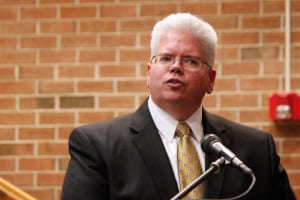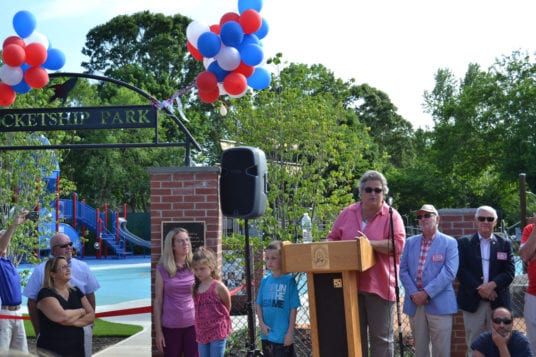Since he was 10 years old, Kevin Foley dreamed of going on his favorite television show, standing behind a podium and giving answers in the form of a question. Last month, the 58-year-old Suffolk County police captain from Mount Sinai finally got his wish as a contestant on “Jeopardy!” where he won a total of $18,000.
“It was the culmination of a lifelong effort,” Foley said of his appearances on two “Jeopardy!” episodes, which aired Dec. 27 and 28. He won his first appearance, raking in $16,000, and fell short of victory in the second, taking home a $2,000 consolation prize for second place. Although he “kicks himself” for the minute error that cost him a win in the second game, failing to risk enough in the final Jeopardy round, Foley said it was an experience he’ll always cherish.
“It was definitely something to check off my bucket list,” he said. “It took me 30-something years to get on there, but I never stopped trying. It’s very satisfying.”
In the late 1960s, Foley, a student in the Plainedge school district at the time, came home for lunch every day and watched “Jeopardy!” with his mother, transfixed by the high-stakes quiz competition then hosted by Art Fleming. The two would bounce the show’s clues off one another, trying to decode them before the contestants did — a routine that continued into the next decade. He said early days with his mother, Dolores Foley, fed right into his already voracious appetite for trivia and knowledge.
“I was the kid that the librarian had to keep telling, ‘No, you can’t take that book out, it’s too advanced for you,’” he said, laughing. “I’ve always read a heck of a lot and retained what I read. My mom was the same way.”
In between the show’s initial cancellation in 1975 and reemergence in 1984 with its new host Alex Trebek, Foley applied to the Suffolk County Police Department, trained in the academy and became an
officer within the 3rd Precinct, officially starting in 1983 when he was 23.
Throughout his career, Foley has served in multiple precincts and was involved in the rescue of a 2-year-old girl who had fallen to the bottom of an in-ground pool. For the past year, Foley has been a precinct delegate for a group called Brotherhood for the Fallen, which sends members of the police department across the country to funerals for law enforcement officers who have been killed. It also provides funds to family members to help with immediate financial needs.
But his desire to be on “Jeopardy!” never went away.
After the show returned to airwaves in 1984, he and his mother would drive to Resorts International in Atlantic City where contestant tryouts were held throughout the year.
“But we never made it past the initial stages,” Foley said of passing the preliminary 50-question written test.
Since the ’80s, he said he swam in the contestant pool for “Jeopardy!” roughly 10 different times — always close but ultimately never chosen. In December 2000, he was one of eight people in the preliminary rounds on “Who Wants to Be a Millionaire?” but never hit the hot seat.
This past May, Foley, like clockwork, took the show’s annual timed, 50-question qualifying exam online, covering the wide range of categories found on the show, with 35 being a passing score. In July, he was called in for an appointment in the show’s Manhattan offices for further tests; mock rounds of the game for evaluation of on-air stage presence and interviews with producers and members of the production staff. In August, he was asked if he was available for tapings in Los Angeles in September.
Foley, who said he reads two or three books a week and “knows a little bit about a lot,” had amassed a collection of “Jeopardy!” books, filled with facts, and studied them every night leading to September.
“He also watched the show every day, he bought a physical at-home version of the game and I constantly quizzed him,” said his wife Joan Foley, who was in the audience during the taping. “It was nerve-wracking to sit there among all these other people and everybody else on the show was so smart. I was so proud of him.”
She said that her husband’s mother, who passed away three summers ago, would have been too.
“His mom is definitely smiling down on him now,” she said.
On Foley’s first night, despite trailing behind in third place with $4,400 to the other contestants’ $5,000 and $7,600 after the first round, he quickly bounced back as champion by the end of the Double Jeopardy! Round, finishing with $16,000 to the others’ $8,799 and $0. He said he most surprised himself during the game by correctly answering with “Drake” to a question in the category of Hip Hop and R&B 2017. “Everyone was like, what is this 58-year-old doing answering this one?” he said laughing. He said it was difficult to process what Trebek said to him during the commercial break as he was too concentrated on the game.
“You kind of get engrossed in it all,” Foley said, adding that the show’s host is not as intense and standoffish as he assumed. “He’s very polite and good-natured — much more personable than I expected him to be.”
While in the lead in his second game against a new batch of contestants, Foley got caught in the show’s strict “to the letter” rules. The category was “Only The Lonely” with the clue reading: “This 12-letter word often followed ‘Miss’ in romantic advice column titles.” Foley answered, “What is Lonelyheart?” to which Trebek responded “yes,” which he retracted seconds later.
“No, sorry,” Trebek said on the heels of the judges’ reevaluation. “We have to rule against you. It’s Miss Lonelyhearts, not Miss Lonelyheart.”
While that one-letter difference cost him $1,600 and a potential second win, his take-home money is making possible a trip in the spring to Yellowstone National Park, a longtime dream destination for he and his wife.
Not to mention Foley’s “Jeopardy!” success has made him a celebrity among friends and co-workers, many of whom were unaware of his appearances until they were about to air. Nearly 100 people attended a viewing party for the episodes, held at Tommy’s Place in Port Jefferson.
“It was so exciting,” said Foley’s longtime friend Roger Rutherford, general manager of Roger’s Frigate, of seeing his 10-year friend’s face up on the big screen. “The place was packed and the second ‘Jeopardy!’ announced who was on the show, the crowd went wild. And every time Kevin’s name was mentioned, the crowd roared with cheers and claps and booing the other competitors. Because of the environment, you would think there was a football game on.”
Jack Catalina, Foley’s best friend and former partner on the force, said he wasn’t surprised by how well he did.
“He’s always looking to show everybody how smart he is,” Catalina said, jokingly. “I was so happy for him, and I think he did very well. He’s always been very good at these types of trivia games.”
So much so, Joan Foley said, that he serves as designated host during family game nights, as it would be too unfair to have him compete.
Foley himself laughed at this, before quoting Herman Edwards, the former head coach of the New York Jets.
“You play to win the game,” he said.










































